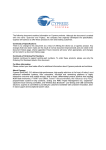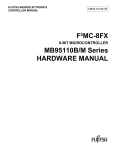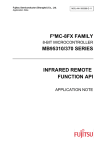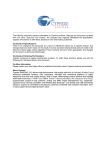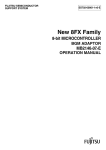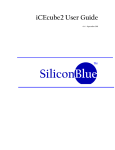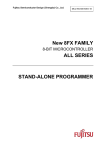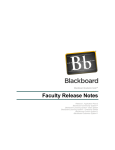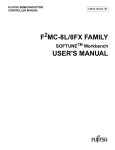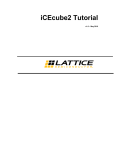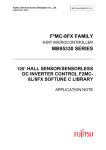Download F²MC-8L/16LX/FR FAMILY
Transcript
Fujitsu Semiconductor (Shanghai) Co., Ltd. Application Note MCU-AN- 500050-E-10 F²MC-8FX FAMILY 8-BIT MICROCONTROLLER MB95310/370 SERIES I2C HARDWARE DESIGN API APPLICATION NOTE I2C Hardware Design API V1.0 Revision History Revision History Date 2009-11-10 Author Jane Li Change of Records V1.0, First draft This manual contains 17 pages. 1. The products described in this manual and the specifications thereof may be changed without prior notice. To obtain up-to-date information and/or specifications, contact your Fujitsu sales representative or Fujitsu authorized dealer. 2. Fujitsu will not be liable for infringement of copyright, industrial property right, or other rights of a third party caused by the use of information or drawings described in this manual. 3. The contents of this manual may not be transferred or copied without the express permission of Fujitsu. 4. The products contained in this manual are not intended for use with equipments which require extremely high reliability such as aerospace equipments, undersea repeaters, nuclear control systems or medical equipments for life support. 5. Some of the products described in this manual may be strategic materials (or special technology) as defined by the Foreign Exchange and Foreign Trade Control Law. In such cases, the products or portions thereof must not be exported without permission as defined under the law. © 2009 Fujitsu Semiconductor (Shanghai) Co., Ltd MCU-AN- 500050-E-10 – Page 2 I2C Hardware Design API V1.0 CONTENTS CONTENTS REVISION HISTORY .............................................................................................................. 2 CONTENTS ............................................................................................................................ 3 1 INTRODUCTION ................................................................................................................ 4 2 BACKGROUND ................................................................................................................. 5 3 DESCRIPTION OF I2C PROTOCOL ................................................................................. 6 3.1 Start Condition .......................................................................................................... 7 3.2 Address ..................................................................................................................... 8 3.3 Acknowledge ............................................................................................................. 9 3.4 Data .......................................................................................................................... 9 3.5 Stop Condition ........................................................................................................ 10 4 I2C HARDWARE DESIGN ............................................................................................... 11 4.1 Hardware Design .................................................................................................... 11 4.2 Pull Up Resister ...................................................................................................... 12 4.3 I2C Electronic Character ......................................................................................... 13 5 USAGE DEMO ................................................................................................................. 14 6 ADDITIONAL INFORMATION ......................................................................................... 16 7 APPENDIX ....................................................................................................................... 17 7.1 Figures .................................................................................................................... 17 7.2 Table ....................................................................................................................... 17 MCU-AN- 500050-E-10 – Page 3 I2C Hardware Design API V1.0 Chapter 1 Introduction 1 Introduction This document introduces API for I2C hardware design. I2C is two wires synchronization protocol in device communication, which has bi-directional wires SDA and SCL. In following chapters we will describe the I2C hardware design and protocol. MCU-AN- 500050-E-10 – Page 4 I2C Hardware Design API V1.0 Chapter 2 Background 2 Background This chapter introduces the background of I2C. In serial extended interface protocol, there are SPI of MOTOROLA, PLUS of NS and I2C of Philips. Compared with others, the I2C is used widely. I2C bus has standard criterion and multitudinous periphery apparatus. The I2C interface is a two-wire, bi-directional bus consisting of a serial data line (SDA) and a serial clock line (SCL). The devices connected to the bus via these two wires can exchange data, and each device can operate as a sender or receiver in accordance with their respective functions based on the unique address assigned to each device. Following are some features of I2C: ¾ integrated Criterion ¾ independent Structure ¾ Easy to use When I2C is used, typical use module of SCM is a small system. It can include I/O, keyboard, display module, clock, A/D, data storage and so on. For what the software become easy and content become more abundance. MCU-AN- 500050-E-10 – Page 5 I2C Hardware Design API V1.0 Chapter 3 Description of I2C Protocol 3 Description of I2C Protocol This chapter describes protocol of I2C. In I2C bus, SCL generates clock and SDA reloads data out and in. Figure 3 – 1 simply describes I2C protocol. Figure 3 - 1 I2C Protocol The slave address is transmitted after a start condition (S) is generated. Data is transmitted after the address. Data can be transmitted continuously to the same slave address. The data is eight bits followed by an acknowledgment. Data transfer is always ended in the master stop condition (P). However, the repeated start condition can be used to transmit the address which indicates a different slave without generating a stop condition. MCU-AN- 500050-E-10 – Page 6 I2C Hardware Design API V1.0 Chapter 3 Description of I2C Protocol 3.1 Start Condition When bus is free, change SDA from high to low while SCL is high will generate a start signal. In MB95F310 writing “1” to register IBCR10_MSS and ICCR0_EN will generate a start signal. Detailed start status refer to Figure 3 – 2. Figure 3 - 2 Status of Starting Start signal can generate again when writing “1” to MCU register IBCR10_SCC. MCU-AN- 500050-E-10 – Page 7 I2C Hardware Design API V1.0 Chapter 3 Description of I2C Protocol 3.2 Address This address is seven bits followed by the data direction bit (R/W) in the eighth bit position. About the direction, “0” is writing and “1” is reading In MB95F310 MCU master mode slave address is written to register IDDR0, when start signal generated data of IDDR0 send out to slave device. Figure 3 - 3 Status of Address MCU-AN- 500050-E-10 – Page 8 I2C Hardware Design API V1.0 Chapter 3 Description of I2C Protocol 3.3 Acknowledge Acknowledge is generated when slave device received address or data. Acknowledge is low level when SCL is in the ninth pulse. Figure 3 - 4 Status of Acknowledge If the SDA is high at the ninth pulse, which indicates that the slave device didn’t receive the address or data from master device. 3.4 Data Whatever writing to/reading from slave device the data is eight bits. Only when master device received the acknowledge data can transmitted out. In MB95F310 MCU the register IDDR0 is used to save the data. MCU-AN- 500050-E-10 – Page 9 I2C Hardware Design API V1.0 Chapter 3 Description of I2C Protocol 3.5 Stop Condition When SCL is high, changing SDA from low to high will generate a stop signal. In MB95F310 MCU writes “0” to register IBCR10_MSS will generate a stop signal. Figure 3 - 5 Status of Stop MCU-AN- 500050-E-10 – Page 10 I2C Hardware Design API V1.0 Chapter 4 I2C Hardware Design 4 I2C Hardware Design This chapter describes hardware design of I2C. 4.1 Hardware Design Actually, I2C is two wires, which are SDA and SCL. Master SDA is connected with slave SDA, and master SCL is connected with slave SCL. Figure 4 – 1 describes the hardware connection in detailed. Figure 4 - 1 I2C Hardware Design MCU-AN- 500050-E-10 – Page 11 I2C Hardware Design API V1.0 Chapter 4 I2C Hardware Design 4.2 Pull Up Resister Because the start signal is generated when SCL is high, so user must connect pull up resister to I2C. The pull up resister is restricted by power voltage. That is because when voltage VOLMAX is 0.4V, the Min current must be 3mA. Figure 4 – 2 describes the relationship between power voltage VDD and pull up resister RP, pull up resister RP and RS. Figure 4 - 2 Resister of Pull Up MCU-AN- 500050-E-10 – Page 12 I2C Hardware Design API V1.0 Chapter 4 I2C Hardware Design 4.3 I2C Electronic Character In order to guarantee I2C transmitting from error, I2C timing is restricted strictly. Table 4 – 1 is I2C bus timing character. Table 4 - 1 I2C Timing Standard Mode Parameter High Speed Mode Unit MIN MAX MIN MAX 0 100 0 400 kHz 4.7 - 1.3 - µs 4 - 0.6 - µs SCL cycle of low level 4.7 - 1.3 - µs SCL cycle of high level 4 - 0.6 - µs Building time of double start signal 4.7 - 0.6 - µs Data building time 250 - 100 - ns Rising time of SDA and SCL - 1000 20 300 ns Dropping time of SDA and SCL - 300 20 300 ns Building time of stop signal 4 - 0.6 - µs Reload Capacity of every transmitting - 400 - 400 pF SCL Frequency Vacant time between first stop signal and second start signal Start holding time About the speed of I2C data transmission it is decided by SCL high level voltage and low level voltage. In actually the transmitting speed can be modified by adding delay for SCL. MCU-AN- 500050-E-10 – Page 13 I2C Hardware Design API V1.0 Chapter 5 Usage Demo 5 Usage Demo This chapter describes the I2C wave and I2C multi connection. In I2C transmitting the signal is transferred synchronously. Figure 5 - 1 shows the status when bit transferring. Figure 5 - 1 I2C Wave The yellow wave is SDA which transfers data. The blue wave is SCL which transfers clock. This wave displays the start condition, data transfer condition, acknowledge generate condition, and stop condition. MCU-AN- 500050-E-10 – Page 14 I2C Hardware Design API V1.0 Chapter 5 Usage Demo One master I2C device can control several I2C devices. Every slave device has only address. When the slave device received the address which is same as itself, the slave device generates acknowledge to master, and then begin to receive data. Figure 5 – 2 describes the situation when one master controls several slave device. Figure 5 - 2 I2C Multi-connection MCU-AN- 500050-E-10 – Page 15 I2C Hardware Design API V1.0 Chapter 6 Additional Information 6 Additional Information For more information about how to use MB95310 EV-board, BGM Adaptor and SOFTUNE, please refer to EV-Board MB2146-450-E User Manual, or visit websites: English version: http://www.fujitsu.com/cn/fsp/services/mcu/mb95/application_notes.html Simplified Chinese Version: http://www.fujitsu.com/cn/fss/services/mcu/mb95/application_notes.html MCU-AN- 500050-E-10 – Page 16 I2C Hardware Design API V1.0 Chapter 7 Appendix 7 Appendix 7.1 Figures Figure 3 - 1 I2C Protocol .......................................................................................................... 6 Figure 3 - 2 Status of Starting .................................................................................................. 7 Figure 3 - 3 Status of Address ................................................................................................. 8 Figure 3 - 4 Status of Acknowledge ......................................................................................... 9 Figure 3 - 5 Status of Stop ..................................................................................................... 10 Figure 4 - 1 I2C Hardware Design ......................................................................................... 11 Figure 4 - 2 Resister of Pull Up .............................................................................................. 12 Figure 5 - 1 I2C Wave ............................................................................................................ 14 Figure 5 - 2 I2C Multi-connection ........................................................................................... 15 7.2 Table Table 4 - 1 I2C Timing ........................................................................................................... 13 MCU-AN- 500050-E-10 – Page 17


















